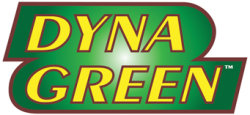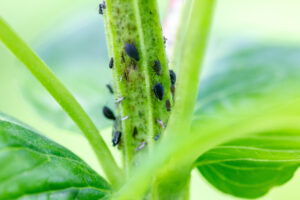| Weed | Description & Controls |
|---|---|
Black Medic (Medicago lupulina) | Low-growing annual or biennial with hairy stems. As with many weeds, gains foothold where grass is thin, especially in dry situations. Small, yellowish flowers usually appear from March to late fall. Control: Thicken turf by feeding, mowing high, and watering to choke out weeds. A good cultural schedule is best defense against all weeds. Apply post-emergence herbicide in early spring and again in fall. |
Buttercup, Creeping (Ranunculus repens)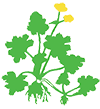 | Low-growing annual or biennial with hairy stems. As with many weeds, gains foothold where grass is thin, especially in dry situations. Small, yellowish flowers usually appear from March to late fall. Control: Thicken turf by feeding, mowing high, and watering to choke out weeds. A good cultural schedule is best defense against all weeds. Apply post-emergence herbicide in early spring and again in fall. |
Carpetweed (Aizoaceae family) | Found across the country. Easy to recognize-many narrow stems, small leaves, and tiny white flowers. Forms thick flat mat. Small greenish-white flowers bloom June to November. Self-seeding. Control: Maintain a thick turf by following a good cultural schedule to choke out weeds. This pest can be killed with post-emergence herbicide in spring or fall. |
Chickweed, Common (Stellaria media)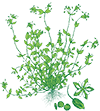 | An annual with delicate, creeping stem that tear easily when pulled. Tangled stems root readily under cool, moist, shady conditions. Found across the country. Produces tiny white, starlike flowers from February into December. Self-seeding. Control: If small infestations, pull weeds early, before first seeds form. Use care to get all stems. For large area, apply post-emergence herbicide in spring or fall. (Speedzone or Trimec) |
Chickweed, Mouse-Ear (Cerastium vulgatum)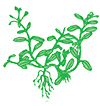 | A creeping perennial that forms dense matlike growth. Tiny white flowers appear from April into October. Prefers moist, cool conditions. Grows in most areas, especially in bright sunlight. Control: Difficult to pull, because it entangles in the grass. Close mowing stimulates growth. Control by applying a post-emergence herbicide. (Speedzone or Trimec) |
Clover, white (Trifolium repens)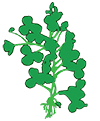 | A perennial readily recognized by typical cloverleaf shape and round white blooms. Spreads by creeping along and rooting in. Self-seeding. Leaves will stain clothing when bruised. Control: Dig out clover as soon as it appears. For large area, use post-emergence herbicide. |
Crabgrass, Common (Digitaria sanguinails) | An annual bunch grass found across the country, except in the Southwest and in southern Florida. Blooms July to October. Doesn’t grow in shade- likes moisture and sun. Seeds mature in late summer and early fall. Control: Follow a good cultural schedule to choke out pests. Mow lawn high during spring to shade germinating seedings. Apply a pre-emergence control in early spring. |
Dandelion (Taraxacum officinale)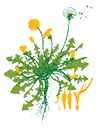 | Found across country except in a few areas of Deep South. Produces coarse-toothed, long leaves in bunch. Bright yellow blooms, followed by round, white seed heads. In cold areas, flowering occurs from March until a freeze; in warm areas, flowering occurs year-round. Control: The entire taproot must be dug out; otherwise, a new plant will grow. Use a post-emergence herbicide in the fall. Spot chemical applications are available. |
Dock, curly (Rumex crispus)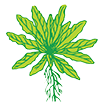 | A perennial with a 11/2 to 2-foot taproot. Produces one or more tall stems. Long, narrow leaves have curly edges and form a strong, tough rosette center. Found across the country. Seldom produces seed in well-maintained turf. Control: If small infestation, dig out, being sure to get the entire root. On larger area, apply a post-emergence herbicide. Apply spray into each plant crown. |
Field Bindweed (Convolvulus arnensis) | Shoots emerge from seeds and rhizomes. Cotyledons are kidney-shaped with a small notch in their tip. Alternate leaves are lobed at their base. Funnel-shaped flowers are white or pink. Control:Time applications to coincide with maximum sugar movement to the roots (late summer or fall). Use systemic herbicides: 2,4-D, dicamba, picloram, dichlobenil, quinclorac, triclopyr. |
Goosegrass (silver grabgrass) (Eleusine indica)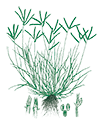 | Prostrate growth habit, and is often white in the center with a wagon-wheel like appearance. Unlike crabgrass, it does not root at the nodes, but grows well in compacted soils. Control:Germinates when soil temperatures reach 60 to 65 °F, and requires moisture and light for germination. Pre-emergence: pendimethalin, sulfentrazone, oxadiazon, dithiopyr, prodiamine. Post-emergence: glyphosate, sethoxydim. |
Ground Ivy (Glechoma hederacea) | Perennial with creeping stems, which root at the node. It forms dense patches and thrives in both sun and shade. The leaves are scalloped along the margin, heavily veined and rough on the upper surface. Funnel-shaped blue/violet flowers are found in clusters in leaf axils and occur in the spring. Control: Apply when in bloom. Post-emergent: clopyralid & triclopyr (Confront, Brazen), 2,4-D & triclopyr (4-Speed XT, Candor), glyphosate. |
Henbit (Lamium amplexicaule)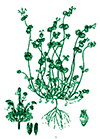 | Winter annual or biennial weed. Stems grow primarily upright but can root at the lower nodes. Leaves are rounded, coarsely toothed, hairy, and deeply veined. Flowers are in whorls in the axils of the upper leaves. Petals are purple and fused into a two-lipped tube Control: Pre-emergent: Simazine, isoxaben, dithiopyr, oryzalin, pendimethalin, prodiamine. Post-emergent: glyphosate, 2,4-D & dicamba & mecoprop & sulfentrazone (Dismiss + Trimec Classic, Surge) |
Pennywort (Hydrocotyle sibthorpioides)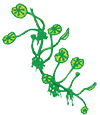 | A perennial that thrives in shady, moist areas in Southern California, from Massachusetts to Florida, and west to Indiana and Texas. Produces small, round, white flower heads July to October. Spreads by seeds and underground stems. Control: Apply a post-emergent herbicide during active growing period. |
Plaintain, Broadleaf (Plantago major)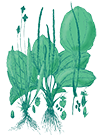 | A perennial (sometimes annual) with broad leaves, 3 to 6 inches long and bunched low. Tall, slender stalks bloom June to October. Spreads by seeds. Control: If small infestation, dig out when soil is moist. For larger area, use a post-emergence herbicide in early spring or fall. |
Prostrate Spruge (Euphorbia humistrata)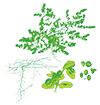 | Summer annual with a taproot; it has an open and prostrate mat-forming growth habit. Milky juice oozes from broken stems. Opposite leaves vary in different colors of green and with a maroon blotch. Flowers are small, pinkish-white, inconspicuous, and borne in the leaf axils. Control: Pre-emergent: Oxadiazon, isoxaben, prodiamine, dithiopyr, oryzalin, pendimethalin. Post-emergent: Spurge Power, Surge, T-Zone, Speedzone, Q-4, Candor, glyphosate |
Purslane (Portulaca oleracea) | Summer annual weed that can reach 8 inches in height. Leaves are thick and fleshy, arranged alternately on the stem, and low and spreading along the ground. Flowers are bright pink, and have five petals. Blooms in late spring and early fall. Control: Post-emergent: 2,4-D & carfentrazone & dicamba & mecoprop – Speedzone, Turflon Ester, Trimec |
Quack grass or Couch grass (Agropyron repens) | A vigorous-spreading perennial bunch grass. Forms a dense root structure by rooting at every joint on underground stems. Found across country except in parts of Southwest and Deep South. It cannot be eradicated without killing lawn grasses, too. Control: Leaf Spot: March-June; Melting out: September-November In KYB, this disease is active in warm/humid weather but in B it is active when it is cool/wet. Leaf spots are seen at the beginning of the disease cycle and this will lead to a melting out of the individual sprigs. Lesions have a yellow halo. Dead plants form irregular patterns. |
Shepherd’s-purse (Capsella bursapastoris) | A persistent annual member of the mustard family that forms a circle of low leaves with white flowers consisting of four petals on tall stems. Seedpods are shaped like a shepherd’s purse. Control: Fairly easy to pull if soil is moist. For larger area, use a post-emergence herbicide. |
Sorrel, Red (Sheep sorrel) (Rumex acetosella) | A perennial that forms a matlike growth in early summer. Found where-ever soil and drainage are poor. Spreads by underground stems and seeds. Yellow-green flowers appear on male plants; female plants bear reddish-brown flowers. Control: Use a post-emergence herbicide in early spring and early fall. |
Thistle, Canada (Cirsium arvense) | Thrives in clay soils in the North. Long prickly leaves and lavender flowers. Spreads by seed and underground roots. Blooms July through October. Control:Use a knife to cut below ground to remove crown and roots. For larger infestation, apply a post-emergence herbicide. |
Yellow Nutsedge (Cyperus esculentus)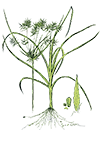 | Rapidly spreading perennial that forms brown- to tan-colored tubers at the tips of rhizomes. Stem is triangular and you can feel it when you roll it between your fingers. Control: Post-emergent: Dismiss, Prosedge |

